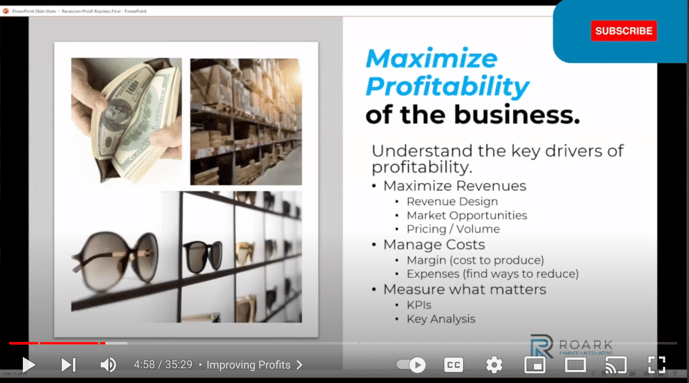
No one likes to think about the possibility of economic downturns. But when it comes to running a small business, it pays to be prepared (pun intended). Being ready for an impending 2023 recession can help your business thrive while others are trying to survive. There are multiple strategies for preparing your small business for a recession. In this post, we’ll dive into one of the ways small business leaders can prepare for a recession: maximizing profits.
Understand the Drivers of Profitability in the Business
To maximize the profitability of a business, you must understand the key drivers of profitability first and foremost.
Maximize Revenues: When we look at maximizing your revenue we think of three things: revenue design through product innovation, market opportunities, and pricing and volume. Start with your revenues first, then you can manage your costs.
Manage Costs: Managing costs improves your margins, whether it's your cost to produce goods or deliver services, as well as your overhead expenses or your expenses that you can manage.
Measure What Matters: Make sure you have solid KPIs and key analysis.
We’ll dive into all of these drivers in a moment.
General Rules for Maximizing Profits During a Recession
To get into the right frame of mind, let’s review some tried and true rules—from business experts and our own experience going through recessions in the past.
Rule #1: Positive state of mind. The effects of a recession on a small business owner can present a mental challenge. It’s vital to start from a positive state of mind. In Good to Great, author Jim Collins uses the example of the Stockdale Paradox to show that productive change begins when you confront hard realities from a positive state of mind.
“You must maintain unwavering faith that you can and will prevail in the end, regardless of the difficulties, and at the same time, have the discipline to confront the most brutal facts of your current reality, whatever they might be.” – jimcollins.com
Rule #2: You can’t cut your way to profits. It’s very difficult to cut your way to profitability unless your expenses are completely out of control. Of course, you must cut costs, and later in this post, we outline ways to do that by rightsizing or outsourcing your finance and accounting services, but cutting costs can only get you so far.
Rule #3: Don’t stop sales and marketing efforts. Regardless of the economy, always continue marketing your business. A lean market allows you to distinguish yourself from other businesses by emphasizing your superior product or outstanding customer service.
Explore paid marketing efforts and less expensive routes, like social media and video sites. Platforms such as Twitter, Facebook, LinkedIn, YouTube, and TikTok offer excellent ways to draw consumer attention without breaking the bank.
During the last significant downturn, ROARK doubled down on communicating that we solve problems even in the most challenging of situations. We are innovative, resourceful, and flexible in overcoming obstacles to deliver outstanding results.
Maximize Revenue with Balanced Revenue Design
We said in the beginning that we start by maximizing revenue, then reducing costs. Take a close look at your revenue streams and ask:
- Do you have recurring revenue?
- Do you mostly have one-time transactions?
- Or a combination of both?
Recurring revenue is ideal because you can count on it each month, and, unless you're losing clients, that revenue stream stays very consistent. One-time transactional revenue streams where there are fewer relationships become more and more difficult because you have to continually find new customers.
People tend to cut back on transactional, one-time transactional services or products during recessions, especially if they’re not mission-critical. Expanding relationships and staying sticky with your customers is very helpful in recession-proofing your small business.
Next, let’s look at your product offerings.
- What products work well in growth?
- What products work well in decline or in recession?
- What do you have now that can be developed into a needed product or service?
This is something that we learned through the business here at ROARK: recessions create market opportunities. Wayne Gretsky said, “Skate where the puck is going to be.” If you are looking forward during a recession, you’ll understand the trends that are happening in the market, then you can get in front of those trends and seize the market opportunity or market share before your competitors.
Pricing and Volume Changes
Now, let’s consider what pricing and volume changes are needed to maximize your revenue.
Don’t delay: Price increases go straight to the bottom line. If you’re thinking about increasing prices or you haven’t increased prices in a while, do not delay. We see too many companies that are afraid to broach the price increase with their clients.
Raise prices incrementally: Small businesses wait and wait until eventually, they have to do a massive increase. Big jumps in price will push your customers to your competitors. Instead, opt for smaller, more frequent price increases that your customers will find more tolerable.
Open communication: Keep your customers in the loop. Make sure you're understanding the relationship between volume and price, and communicate openly with your customers so there are no surprises.
Strike a balance: Find the sweet spot between raising prices just to stay ahead and raising prices too much to the point of lower demand. Offer discounts and incentives, and solve problems for your customers during difficult times. They’ll remember.
Reduce Costs to Produce Goods & Services
Your cost to produce products or deliver services can be one of your highest cost centers. When the economy is going well and we’re focusing on growth, we may not be worried about these costs of doing business. Now is the time to have a closer look.
Where can you reduce costs?
- Renegotiate costs with vendors
- Rightsize purchase volumes
- Reduce labor costs
- Automate and streamline
Negotiate where you can: renegotiate contracts with vendors, find new partners, and reach out to your technology platforms. With a declining market, there’s more capacity and salespeople are always looking to capture market share. Make sure you're looking at those opportunities and rightsizing your volumes, subscription levels, and other purchases.
Employees are typically your most expensive line item, second to the direct cost of being able to produce or deliver services.
Who are the A, B and C players on your team? It may be time to start shedding the C players, evaluate the B players, and ensure you’re maintaining the A players. If you're holding on to B and C players, consider if that fosters an environment in which A players want to be in. Finally, be on the hunt for those A players because downturns breed instability and layoffs, which you can capitalize on. This may be the right time for an Executive Search to find those A-players that can make a positive impact for your organization.
Where can you automate? Now is the time to find jobs and tasks to automate and processes you can streamline to gain efficiency. One way we’re helping our clients do this is by providing Finance & Accounting as a Service. Learn more about how you can get accounting, controllership, planning, and finance services—all under one roof.
Reduce Expenses to Improve Profitability
Your next line item to examine is SG&A. Overspending can get out of control during the good times, so reducing expenses is necessary as we prepare for a recession.
These costs can get forgotten or hidden, so it's time to go through each one of these line items on your P&L and evaluate what you need, what you don’t need, what’s working and providing value, and what can be cut.
A good way to do this is by implementing zero-based budgeting. Start with a clean sheet of paper and estimate where you think revenue and expenses will be, then compare that to what you have. Many times you’ll find fat to cut and expenses that aren’t providing value. Then, make sure you're reviewing the investments that you're making in the future of the company—R&D, sales, marketing, etc.
As we said earlier, you have to be careful in cutting these expenses. Invest carefully. If recession is on the horizon, conserve cash to ensure you make it through.
What Gets Measured Gets Improved
Management theorist Peter Drucker said, “What gets measured gets improved.”
And we agree. Know the value of your data, measure the right things, and hold people accountable. The best way to do that is to develop good KPIs and report through scorecards.
Scorecards are critical to keeping you on track. Scorecards let you report on your KPIs weekly and keep a pulse on your business.
What to include in your scorecard?
- Profitability
- Financial performance as well as financial position to the balance
- Department performance
- Employee performance
For example, at ROARK we look at “the big three” which are the three most important things to do the job and the measures for those.
I highly recommend using a red, yellow, and green system in your dashboards and your scorecards. Then you can easily see the areas that are on-track, off-track, and be able to address them.
Use These Key Calculations for KPIs
Use common business ratios to calculate your numbers.
One such ratio is your company’s break-even point. You can calculate this using a simple formula:
Fixed Costs ÷ (Price - Variable Costs) = Break-even Point in Units.
Then, compare this to your revenue drivers.
Another critical metric is the cost of customer acquisition.
You can find this by adding up advertising costs, the salary of your marketers, the costs of your salespeople and dividing that by the number of customers acquired.
Customers Value X Average Customer Lifespace
Customer Value = Average Purchase Value X Average # of Purchases
One last thing that some business owners overlook is revenue per employee.
Revenue Per Employee = Total Revenue / Total Number of Employees
This will help you know when it’s time to scale up or potentially scale down from an employee perspective.
Partner with Trusted Finance & Accounting Experts
Regardless of the state of the economy, it's essential to prepare your small business to weather any storm. Prudent financial practices not only provide the foundation for a successful business but also afford assurance that your small business will remain viable in good times and bad.
We offer a flexible, cost-effective solution perfect for small businesses through our Finance & Accounting as a Service (FAaaS). Business owners enjoy these benefits:
- Receive timely, accurate financial information that your entire team can rely on.
- Consult with CFOs and Controllers on business strategy and compliance at a fraction of the cost.
- Easily scale your business with ROARK's collective knowledge and industry experience.
- Outsource any role quickly—never worry about turnover again!
Ready to get the compliance and reporting you need to help your small business thrive in a recession? Contact us today.



